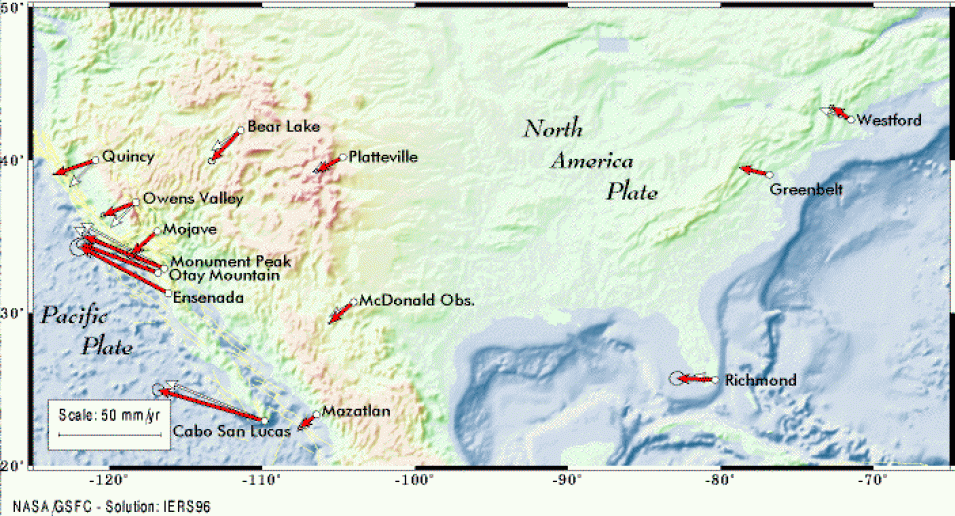Reference Frame
The horizontal components of tectonic motion that have been estimated from NASA's Goddard Space Flight Center analysis of Satellite Laser RangingS(SLR) data are plotted as red vectors on this map. The white vectors represent the motions for the sites as given by the NUVEL-1A geologically determined plate motion model. The frame within which these motions are placed is defined mathematically such that, in an integrated sense, there is no uniform net rotation remaining (called a "no net rotation" frame, or NNR frame). Please keep in mind that this is a mathematical idealization and that these motions only approximate the velocity relative to a fixed mantle.
Broad Description
There are 14 SLR stations plotted on the immense area of this map. See below for more details for each, generally moving from west to east.
Sites West of the Pacific-North America Boundary
These involve four sites: two in Mexico and two in southern California. At the southern tip of the Baja Peninsula is Cabo San Lucas, Mexico. Here, SLR estimates a motion which is 52 mm/yr, in good agreement with that expected from the NNR-NUVEL1A model for Pacific motion. There is an 8-degree difference in the direction, an explanation for which is lacking at this time. Further north, at Ensenada, Mexico, the SLR estimate of motion agrees very well with Pacific NNR-NUVEL1A motion.
To the northeast of Ensenada, we cross into the United States and we see that the motions estimated from SLR for the sites at Otay Mountain and Monument Peak in California are somewhat slower than what the NNR-NUVEL1A model suggests and differ approximately 10 degrees in direction. This situation is best understood when it is recognized that the accrual of strike/slip motion of the Pacific plate relative to North America is distributed over a broad boundary zone rather than a single fault. In other words, as we travel westward across the boundary of the North America and Pacific plates, the transition between North American and Pacific motion is not abrupt, but is gradual. As we get further onto the Pacific plate, plate motion will grow to full plate rate. There are several faults to the west of the Otay Mountain and Monument Peak tracking sites which have an active component of strike/slip motion, thus these two SLR sites are said to be in the western edge of the plate boundary deformation zone.
Remaining Sites in California
There are three remaining sites in California which nominally reside on the North America plate. The southernmost of these is Mojave, and its SLR estimated motion is very similar to that expected for North America modeled motion based on the NNR-NUVEL1A model. Farther north, at Owens Valley and Quincy, we begin to see, again, deflected vector motions relative to the model. This is attributed to a counter-clockwise block rotation of the Sierra Nevada microblock.
Other North American Sites
Working eastward, the motions estimated for Bear Lake, Utah; Platteville, Colorado; and McDonald Observatory, Texas all show some slight deviations from the geologic model. These deviations may be due to more localized surface processes.
Along the east coast of the United States are sites in Richmond, Florida; Greenbelt, Maryland; and Westford, Massachusetts. The site in Richmond is periodically visited by one of the mobile SLR systems. The tracking history from this site is not all that extensive, hence, the somewhat larger uncertainty ellipse. Greenbelt serves as one of the fiducial sites by which the reference frame is defined. It has no uncertainty ellipse since both the north and east components of its motion are defined by the NNR-NUVEL1A model. The other constraint is defined by the northward motion of the site at Maui (see the Pacific Basin map). The motion of Westford exhibits general North America plate motion.
